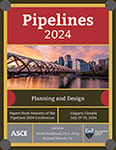The Theory and Practice of Designing a Seismically Resilient 72-in. Diameter Pipeline That Crosses the Wasatch Fault Zone
Publication: Pipelines 2024
ABSTRACT
The Davis Aqueduct is a 22.5-mi-long pipeline made of reinforced concrete pipe ranging in diameter from 84 in. to 21 in. It is the only source of water for several cities in Weber and Davis Counties and in the Great Salt Lake Basin. The Aqueduct sits along the Wasatch front range of the Rocky Mountains and is within the Wasatch Fault Zone (WFZ) for much of the alignment. In addition to the seismic risk, the aqueduct is also at risk of damage from landslides, debris flows, and liquefaction. The Weber Basin Water Conservancy District (WBWCD) serves a population of over 500,000 in Weber and Davis Counties. WBWCD performed a risk assessment, condition assessment, and hydraulic evaluation of the Davis Aqueduct to define its long-term repair and replacement strategy and coordinated that strategy with the State of Utah’s Prepare60 initiative. To mitigate the risk associated with loss of service, the District proposed a parallel pipeline to accomplish two objectives: (1) increase hydraulic capacity, and (2) provide redundancy for the existing pipeline. A goal for the parallel pipeline project was to design the most resilient system possible to help WBWCD maintain high level-of-service goals for critical turnouts. In preliminary design, Brown and Caldwell conducted an alignment study and a geologic hazard assessment to identify, characterize, and define geological and seismic hazards in a potential pipeline corridor from the start of the existing aqueduct to the turnout to Weber Basin’s Davis North Water treatment plant. Seven alignments were considered, and a preferred alignment was selected that prioritized hazard avoidance before hazard mitigation. This paper focuses on the strategy implemented to avoid risks during preliminary design and how the pipe was designed to be resilient when crossing of the Wasatch Fault and passing through three zones with anticipated liquefaction and an area with slope instability. The final design included upgrading the bifurication structure which controls flow at the start of the pipeline, designing a pump station that allows the Davis Aqueduct to divert flow from or into an adjacent canal, and protecting the pipe from landslides on unstable slopes near the terminus of the pipeline and the hydraulic structure which controls flow at the end of pipeline.
Get full access to this chapter
View all available purchase options and get full access to this chapter.
REFERENCES
American Lifelines Alliance. (2005). Seismic guidelines for water pipelines. FEMA- National Institute of Building Sciences. https://www.americanlifelinesalliance.com/pdf/SeismicGuidelines_WaterPipelines_P1.pdf.
Honegger, D. G. (2017). Pipeline seismic design and assessment guideline (PR-268-134501-R01). Pipeline Research Council International. https://doi.org/10.55274/R0011445.
Information & Authors
Information
Published In
History
Published online: Aug 30, 2024
Authors
Metrics & Citations
Metrics
Citations
Download citation
If you have the appropriate software installed, you can download article citation data to the citation manager of your choice. Simply select your manager software from the list below and click Download.
